How to select adaptive math software that meets your needs
Choosing an online math program is more challenging than ever, given the proliferation of digital curriculum programs and more rigorous common core and other standards. Learn how to evaluate digital curriculum that meets the foundational principles that form the foundation of the new math standards: focus, coherence, and rigor.
Realize the Promise of Personalized Learning in Mathematics
Digital learning technology such as adaptive software captures every decision a student makes and adjusts their learning path accordingly. This design identifies learning gaps and determines goals with “just right” individualized lessons. Adaptive software supports teachers with ongoing and continuous formative assessment to differentiate for all students, and fosters a more collaborative classroom where students are engaged and self-directed.
As more districts implement Blended Learning or transition to an all-digital curriculum, they are evaluating how curriculum programs align with state and regional standards and their overall vision of 21st Century learning. Adaptive software can be an important part of a district’s deployment of learning strategies that personalize learning for students and improve student outcomes.
In this buyer’s guide you’ll discover:
Five Essential Elements for Comparing Online Math Curriculum
You’ll find answers to all of your questions surrounding the following key issues:
- Focus, Coherence, and Rigor: These elements provide the foundation for engaging each student in rich and rigorous curriculum to deepen understanding and improve achievement.
- Deep Learning and Independent Problem Solving: Creating digital lessons, tools, and games that empower students to design their own solutions reinforces problem solving and other critical thinking skills. Even when a student is allowed to explore potential solutions, there is a real need to provide visual and auditory supports for vocabulary development, acquisition, and usage.
- Assessment and Scaffolding: This category gets to the heart of how and when assessment is happening and the level of detailed feedback that is provided by the program.
- Individual Learning Paths: The goal of personalized learning is that each student has their own unique learning path. Students must be allowed to exercise personal choice in the math curriculum in order to take ownership of their learning.
- Classroom Partnership: Teachers must have access to informed reports that allow them to identify learning gaps and assess specific goals that enable each student on their individualized learning path.
@DreamBox_Learn










